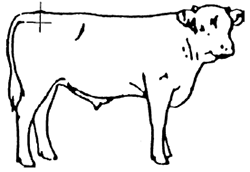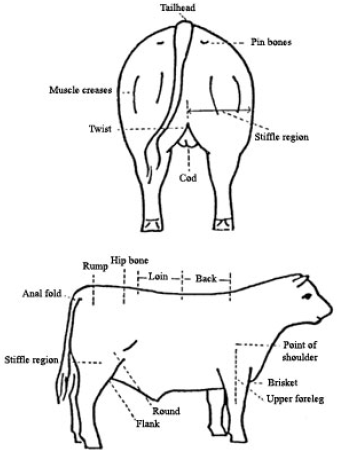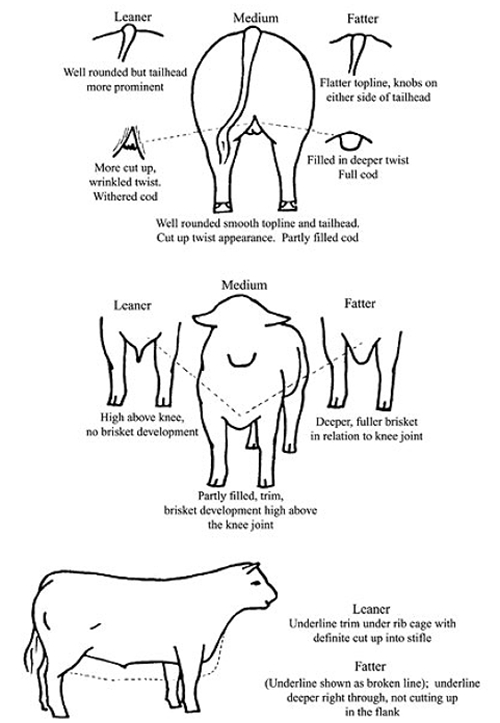The Amount of Fat Cover on a Beef Animal Is Called
Fatness is an important component of the beef carcase.
Red meat consumers in both domestic and export markets are becoming increasingly specific in their requirements, particularly in relation to the fatness of meat. Successful beef producers of the time to come will need to breed and manage their cattle to adjust the requirement of a particular market place, and to do this, they must exist able to assess the fatness of live cattle.
Premium prices are paid for carcasses that accept the acceptable fat depth for a item market place.
While very lean carcasses with fat depths of 0, 1 and 2 millimetres may be considered too lean, carcasses with more than 12 or 15 millimetres could be considered besides fat.
For example:
- A particular marketplace requiring carcasses weighing between 180 and 220 kilograms (hot standard carcase weight) ideally requires a fat cover of from five to nine millimetres at the P8 rump site. Carcasses of this weight with less fat may exist blank on fundamental cutting areas and are therefore hard to market. On the other manus, the same carcase with from 12 to 15 millimetres volition require trimming, which is expensive in terms of time and lost weight.
P8 site for measurement of fat depth
The two intersecting lines on Figure 1 bespeak the position of the P8 site on the brute.

Fat depth in cattle refers to the depth of fat at 1 particular point on the animal — in this case, the P8 site. The depth of fat at this site reflects the percentage of fat in the carcase and the subsequent meat yield.
Technique for assessing P8 fat depth
To assess fat depth on live cattle it is necessary to both visually appraise cattle and, wherever possible, handle the animals at particular reference points.
Treatment the animal to assess fat depth
This is the technique by which fat depth at the P8 (rump site) tin be assessed where cattle tin be handled.
When an animal is handled, bone feels hard, muscle feels firm and fat feels quite soft.
The main sites to feel on an creature for fat depth are:
- over the hip where fat volition be deposited
- thickness of the anal fold (where tail joins the body)
- along the backbone over the rump surface area
- P8 site.
Over the hip
A 'soft' hip indicates that fatty is present.
A 'hard' hip indicates the lack of fat.
Thickness of the anal fold
A thick, spongy fold indicates that fat is nowadays.
A feel of a double fold of pare without 'padding' in between indicates the lack of fatty.
Feeling forth the backbone over the rump expanse
A soft, spongy feel indicates fat.
A hard, solid experience indicates the lack of fat.
Feeling the P8 site
The final expanse of assessment is on the P8 site, which is over a big layer of muscles. In assessing this site, y'all need to develop the skill of determining the fatty depth without becoming confused with 'musculus bounce'.
Assessing the fat depth at the P8 site
A guide to assessing fat depth at the P8 site is:
- Hip os highly visible and hands felt as difficult os; no fatty in brisket (lower signal of the skeleton where the foreribs join together) or flank (the fleshy part of the side between the ribs and the hip). No filling in anal fold. Spine easily felt over the rump (private vertebra felt) — the depth of fat is 0 to two mm (fat score 1) .
- Hip bone feels difficult considering of lack of fat cover — a light deposit of fat in brisket and flank. Anal fold has soft feeling indicating presence of modest amount of fat.
- Spine over the rump area can be felt merely vertebrae experience rounded — the depth of fat is 3 to 6 mm (fat score 2).
- Hips tending to feel layered with fatty, giving a feeling of soft tissue beneath the hibernate. Fat in brisket and flank is obvious. Anal fold filled with fatty tissue, which can be easily detected when pinched. Spine over the rump area can be felt with firm force per unit area — the depth of fat is 7 to 12 mm (fat score 3).
- Hips are no longer noticeable because of heavy layer of fatty. Brisket appears to be well adult, flank fat very obvious. Anal fold bulging with fat, feeling thick and spongy. Spine cannot be felt considering of a heavy layer of fat, which tends to 'bounce' when tapped — the depth of fatty is 13 to 22mm (fat score iv).
- All os structure and tail are buried in fatty tissue with folds of fat covering hips. Anal fold extremely total. Heavy layer of fatty tissue over rump area, very 'bouncy' when tapped — the depth of fat is 23 to 32mm (fat score v).
- Grossly fatty animal, giving an appearance of blockiness with folds of fat around hips, tail and ribs. A very large brisket and deep torso because of heavy layer of fatty along underline — the depth of fatty is 33+ mm (fat score 6).
When assessing fat cover, it is important to be able to distinguish between fat deposit and muscle as they both influence the shape of the animal.
Cattle with no depth of fatty are considered fat score 0 and are to be treated every bit a welfare take chances and veterinarian communication should engaged for the management of these cattle.
Visual cess of cattle
When assessing cattle visually, every bit tin can be done both in the yards or in the paddock, there are particular reference points to written report.
The three main sites used in visual appraisal are:
- brisket
- the underline including the flank
- the rear view taking in the twist, cod and tailhead area.
The brisket and the rear view are probably the most useful reference points when assessing for fat cover.
The brisket
The brisket is the lower point of the skeleton where the foreribs join together. In this area, footling musculus is laid down and excess tissue will be fat.
Ideally, the brisket should be partly filled, trim, and loftier above the knee joint.
Deeper, fuller briskets are only filled with fat, and this indicates that there could also be excessive fatty deposits on other areas of the carcase.
The rear
When viewing the leaner type of animate being from the rear, the leanness will be indicated by roundness over the summit, the prominence of the tail caput, a cut-up and wrinkled appearance in the twist and little or no cod development.
Animals carrying a heavy fat cover, when viewed from the rear, volition have a foursquare appearance over the top, knobs (of fatty) on both side of the tail head, a fuller and deeper twist and greater development of the cod.

Underline and flank
The flank area is an expanse where muscles exercise not develop. In lean animals, the underline will be trim under the rib cage, loftier above the genu and will cutting up in the flank.
If the underline is deeper and does not cutting up in the flank, this indicates the presence of fat. Fat cover is hard to estimate and can be confusing because information technology may be poorly distributed throughout the body.
Arriving at a balanced estimate
The master problem is that steers rarely display all the correct features at any fourth dimension. Therefore, it is best to appraise all of the reference points mentioned and go far at a balanced estimate.
To develop and apply this skill with conviction, y'all need carcase feedback. At present the only alternatives available to you are to:
- follow your own cattle through meatworks to see the fatty cover of the carcase and study the carcase feedback
- participate in exercises of live animal assessment and in carcase competitions
- employ an ultrasonic fat measuring device
There are a range of service providers that are currently fatty and muscle scanning cattle, thire service can be contracted for authentic fat assessment.

reyesmamrainy1941.blogspot.com
Source: https://agriculture.vic.gov.au/livestock-and-animals/beef/handling-and-management/assessing-fat-depth-of-live-cattle
Post a Comment for "The Amount of Fat Cover on a Beef Animal Is Called"